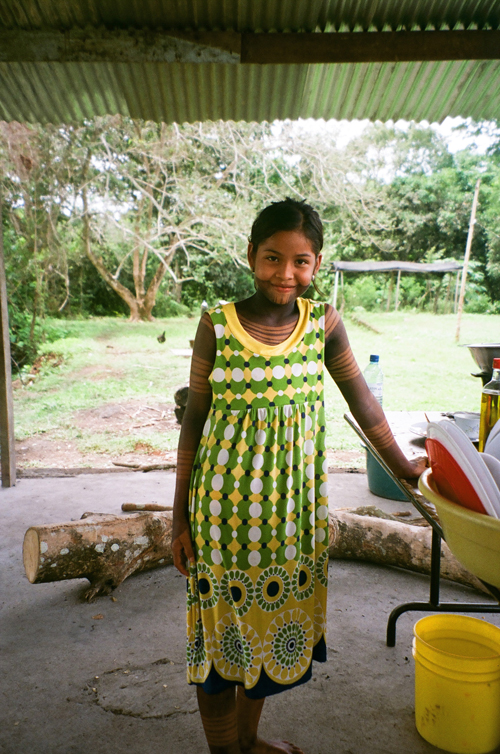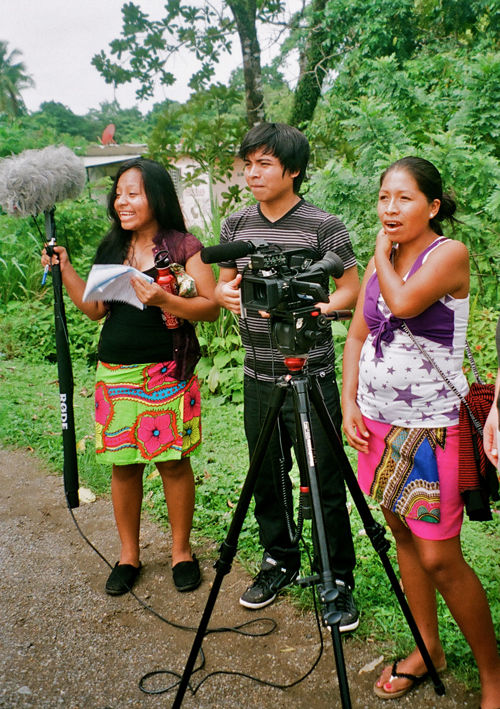
By Anthony Sardain
A dark-skinned woman with waist-length black hair dips her brush in a wooden bowl filled with blue ink. She coats the shoulders of a small child, careful to avoid the ornate bands painted on the girl’s upper arm. Somewhere a rooster calls, and a horse stamps under the heat of the Panamanian sun. The woman instructs the child in Emberá to dip her hands in the bowl.
“¡Corte!”
The woman puts down her brush and looks up at the cameras pointed at her. “How was it, Ivan?” she asks the director in Spanish. The director, a young Emberá man of about 20 years, smiles in reply and calls out instructions to the crew. Eight young men and women – some Emberá, some belonging to other indigenous groups – each holding different pieces of recording equipment, reposition themselves and prepare for the next scene. Watching them, one can hardly believe that three days ago none of these kids had ever touched a camera.
Over the span of a week, this group of young filmmakers is expected to shoot a documentary and present it at the closing ceremonies of the first Bayano film festival in eastern Panama. The festival, the first of its kind, takes place in a different town each night and screens films that touch upon issues relevant to Panama’s rural and indigenous communities.
For the past 40 years, the Bayano has been marked by land-conflicts between the region’s two primary indigenous groups, the Kuna and the Emberá, as well as the campesino peasant farmers. Conceived by McGill University professor Dr. Catherine Potvin, the festival is part of an effort to bring together the three groups and to foster a spirit of cooperation between them. The documentary to be presented at the end of the festival is itself an embodiment of this spirit of cooperation; the young men and women in charge of planning, filming, and editing the documentary are all either Emberá, Kuna, or campesino.

This project is made possible by the Wapikoni Mobile foundation, a Québecois organization that organizes cinematography workshops in indigenous communities around the world, as a means of giving them a voice and increasing their visibility; the foundation has funded similar projects in Bolivia, Chile, and Peru. Under the guidance of Frédéric Julien and Manon Barbeau, as well as Marie-Pier Ottawa, a young Canadian filmmaker of Atikamekw descent, the team of Panamanians was taught the basics of filmmaking, from the conception of an idea to its edition and completion.
The documentary project goes beyond encouraging collaboration between the peoples of the Bayano; it is equally an opportunity to engage in self-examination. The indigenous groups of Panama are in the midst of a cultural crisis. The influence of the city has brought about many changes in the country’s indigenous communities: diets have changed to include more oils and meats; cultural practices have begun to lose their significance; and traditional knowledge is disappearing as many of the youth flock to the city to receive formal education. The loss of culture is not happening at a slow rate either; although many young Emberá can understand the Emberá language spoken by their abuelos, very few can speak fluently.
![94510009[1]](https://reporter.mcgill.ca/wp-content/uploads/2013/10/945100091.jpg)
To see videos about Professor Catherine Potvin and her student’s adventures in Panama and how they relate to climate change click here.
Anthony Sardain is an undergraduate student in Biology in his final year. Since January 2013 he has been working with Dr. Catherine Potvin and the Smithsonian Institute of Tropical Research to create a dashboard of indicators of sustainability for Panama.

Great article Anthony! I’m jealous you got to participate in that very cool event and in such as amazing setting!